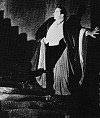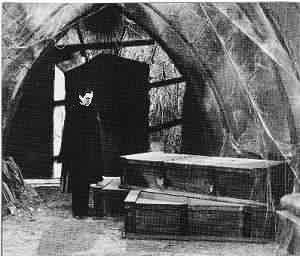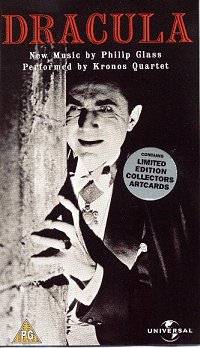|
|

This is a new score for the classic Bela Lugosi Dracula film made by Universal
back in 1931. I am reviewing the score on its purely musical terms in this
review. A separate review of the video looks at the aptness of Glass's music
for the film.
Following on from Herrmann's Psycho score, Glass has chosen to use a
monochromatic score utilising just strings, and the close, limited configuration
of a quartet for this Gothic black and white film. Glass's minimalistic style
is prevalent but he uses multi-part writing, many string playing techniques,
considerably varied colours, dynamics and shadings, abrupt gear changes or
smoother modulations to sustain the interest. And yet, after about 40 minutes,
I have to admit I felt tedium setting in because of the relentless repetiton
of like material. This album would have been more effective for some ruthless
editing coupled with a judicious choice of material.
 The
album opens with the main Dracula theme: dark swirling, demented and tormented
figures supporting screeching and piercing high-pitched staccato chords.
The evocative and atmospheric cues work well: cantering, galloping figures
for the 'Journey to the Inn', the swiftly shifting textures suggesting violent
gales for 'The Storm' and the swirling dense motifs for 'London Fog' with
its hints of hidden menaces. A dark, dank and creaky immensity is suggested
by the music for 'The Castle' and the disturbing high-pitched glissandi denote
only too well the 'Horrible Tragedy.' I thought the evocation of 'The Three
Consorts of Dracula' was rather bland and could have been more alluring after
all they are supposed to seduce their male victims but the 'Women in White'
suggests some sympathy for these condemned creatures. 'Excellent, Mr Renfield'
impressed in as much as it suggested a conversation piece with Renfield prattling
on about the legalities of the sale he has come to Dracula's castle to negotiate
while Dracula looks on with more bloody thoughts on his mind. 'Lucy's Bitten'
brings out the more colourfully melodramatic with Glass pointing up all the
fear and anguish and almost panic of the discovery of the affects Dracula's
dining session. An interesting experiment. The
album opens with the main Dracula theme: dark swirling, demented and tormented
figures supporting screeching and piercing high-pitched staccato chords.
The evocative and atmospheric cues work well: cantering, galloping figures
for the 'Journey to the Inn', the swiftly shifting textures suggesting violent
gales for 'The Storm' and the swirling dense motifs for 'London Fog' with
its hints of hidden menaces. A dark, dank and creaky immensity is suggested
by the music for 'The Castle' and the disturbing high-pitched glissandi denote
only too well the 'Horrible Tragedy.' I thought the evocation of 'The Three
Consorts of Dracula' was rather bland and could have been more alluring after
all they are supposed to seduce their male victims but the 'Women in White'
suggests some sympathy for these condemned creatures. 'Excellent, Mr Renfield'
impressed in as much as it suggested a conversation piece with Renfield prattling
on about the legalities of the sale he has come to Dracula's castle to negotiate
while Dracula looks on with more bloody thoughts on his mind. 'Lucy's Bitten'
brings out the more colourfully melodramatic with Glass pointing up all the
fear and anguish and almost panic of the discovery of the affects Dracula's
dining session. An interesting experiment.

Reviewer
Ian Lace

The Video
DRACULA the 1931 Universal Film Directed by Tod Browning and starring
Bela Lugosi.  Digitally
enhanced and remastered Edition and scored for the first time in 68 years
with New Music by Philip Glass and performed by the Kronos
Quartet. Digitally
enhanced and remastered Edition and scored for the first time in 68 years
with New Music by Philip Glass and performed by the Kronos
Quartet.  UNIVERSAL
HOME VIDEO 061 9383 [75 mins] UNIVERSAL
HOME VIDEO 061 9383 [75 mins]
|
 |
Save around 22% with
Yalplay |

I admit to listening to the CD of Glass's music and writing the review of
it before I acquired this video. First, a little about the film. There is
no doubt that it belongs to Bela Lugosi - evil elegance personified; and
those eyes, full of arrogant malice and so cleverly lit under the inspired
direction of Browning - unforgettable. Looking at this film again after all
these years, one is struck by the fact that all the blood-letting occurs
off-stage its all so heavily suggestive but non the less horrific for that.
Yes the acting is hesitant and stilted, and heavily melodramatic but that
is its period charm. [I was watching Dracula Dead and Loving It,
last week on TV, and I was interested to note how Peter MacNicol (Ally
McBeal's 'The Biscuit') so closely emulated the mad insect-eating Renfield
as portrayed in in this production - in fact, if anything, the actor in this
1931 film is even more of a caricature!] The art direction apart from some
awful cardboard mountains near the beginning is wonderfully atmospheric.
So does the music fit the film? Well yes, on the whole, I think it does.
It is well balanced so that it is audible and influences the mood of the
scenes but not obtrusive enough to draw attention to itself and often one
forgets it is there although its presence clearly heightens the dramatic
tension. Whether or not this tension would have been heightened by a more
colourfully varied score, employing more orchestral resource, is debatable
bearing in mind the film's rather trapped and claustrophobic atmosphere.
My review of the CD above gives a reasonable impression of the use of the
score, although a misprint on the CD cover has prompted me into a false
assumption. 'Women in White' should surely have been 'Woman in White?' For
this cue surely is for the scene where the undead Lucy is terrorising the
surrounding countryside in her bloodlust and has 'taken' two young children,
so my original observation, that the music 'suggests some sympathy for these
condemned creatures' must therefore be applied to the children.
An interesting if not completely successful musical experiment for a classic
which looks very good in its new refurbishment.
Film - 
Music in the context of the film -

Reviewer
Ian Lace
|
Reviewer
Ian Lace

Reviews from previous
months
Reviews carry sales links
but you can also purchase
from:



 |
|
![]()
![]()
![]()
![]()
![]()
![]()
![]()
![]()
![]()
![]()
![]()
![]()
![]()
![]()
![]()
![]()